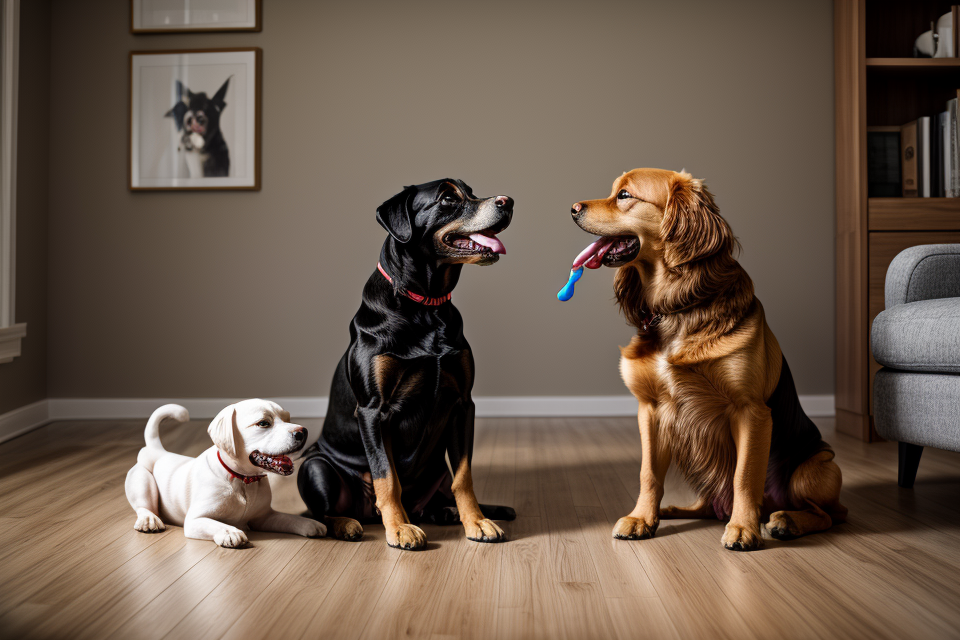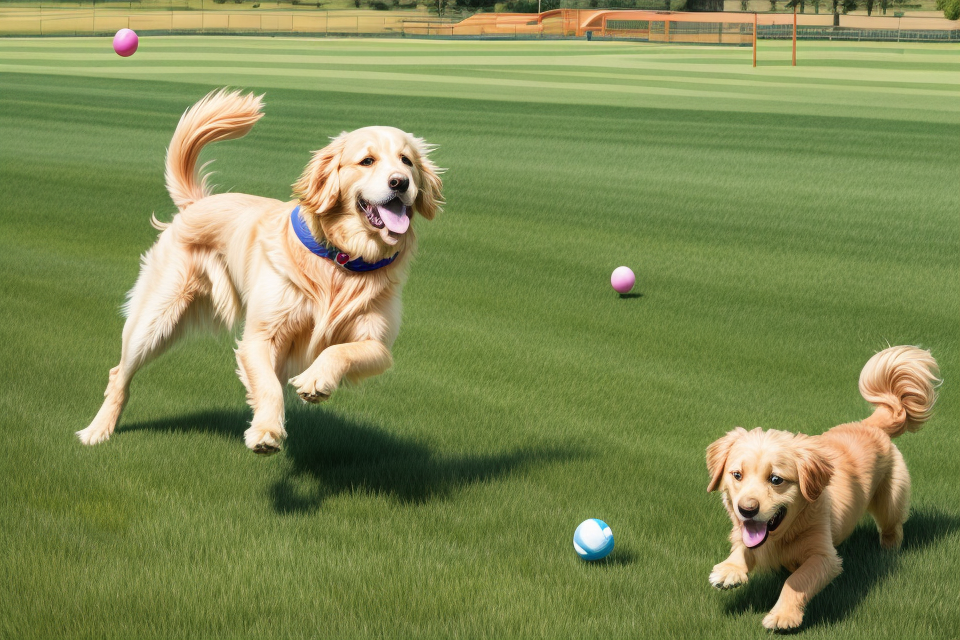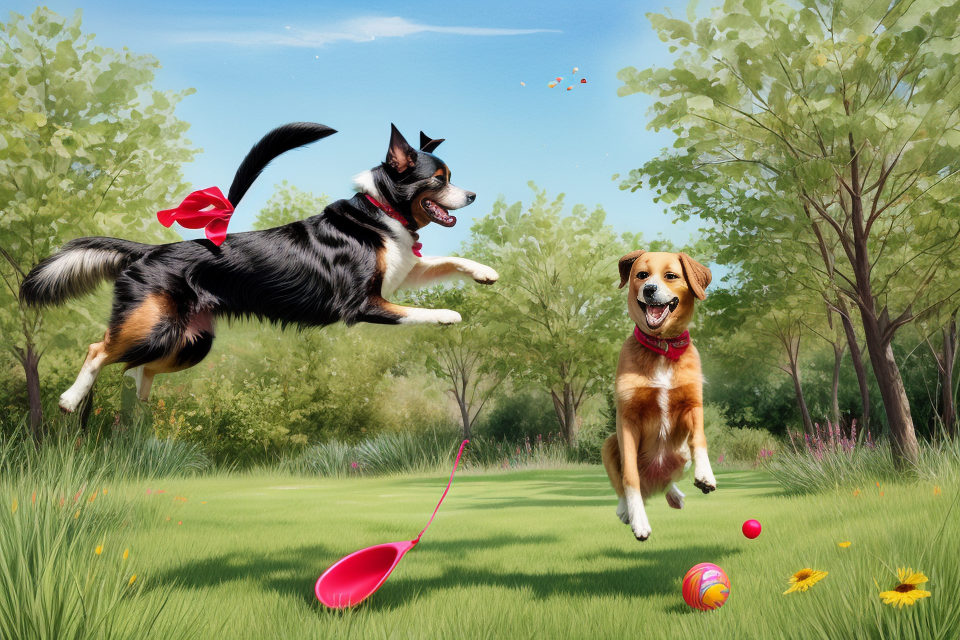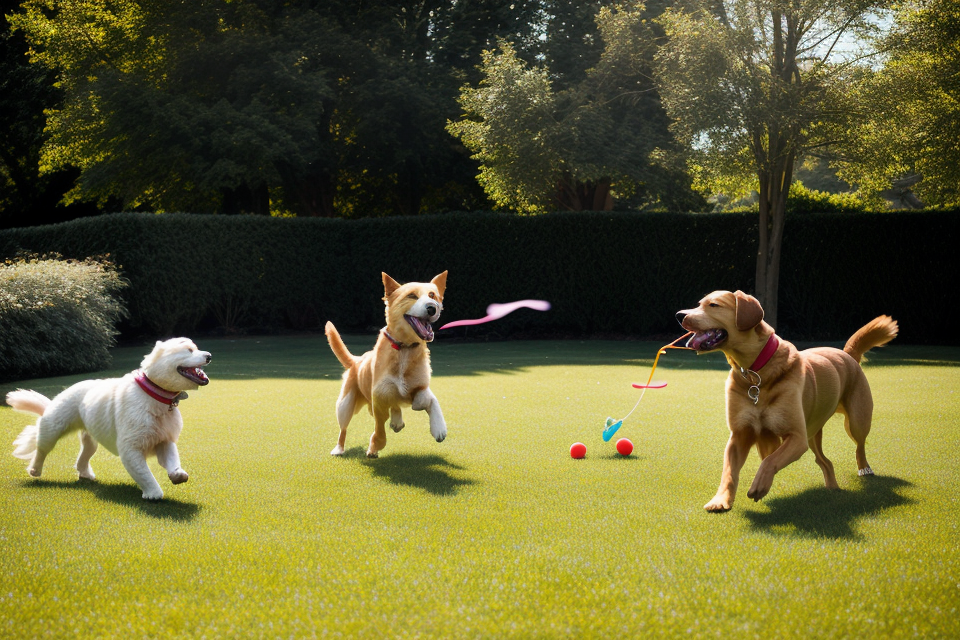Are you tired of coming home to find your beloved furry friend wagging their tail and eagerly holding a toy in their mouth? You’re not alone! Many dog owners have experienced the frustration of walking through the door, only to be greeted by a playful pup clutching a toy. But why does this phenomenon occur? Why do dogs always seem to grab a toy when their owners come home? In this article, we’ll dive deep into the world of fetch toys and uncover the fascinating reasons behind this adorable behavior. From the science of canine cognition to the psychology of play, we’ll explore the many factors that contribute to your dog’s unwavering love for toys and the joy they bring to your home. So, grab a treat and let’s get started!
Dogs are known for their loyalty and affection towards their owners, and one common behavior that demonstrates this is when they grab a toy when their owner comes home. This behavior is often seen in dogs that play fetch, as they will run to their owner with a toy in their mouth, ready to play. The reason for this behavior is likely due to the dog’s desire to please their owner and receive positive reinforcement. When the owner returns home, the dog is excited and wants to interact with them in a way that they know will bring joy to their owner. The act of bringing a toy is a way for the dog to initiate play and spend time with their owner. Additionally, it may also be a way for the dog to release energy and play, which is a natural instinct for them. Overall, the behavior of grabbing a toy when coming home is a sign of a dog’s love and eagerness to spend time with their owner.
Understanding the Fetch Toy Behavior
The Science Behind Fetch Toys
Fetch toys have been a staple in dog play for centuries, but what makes them so appealing to our furry friends? The science behind fetch toys can be attributed to several factors, including the importance of mental stimulation, the role of play in canine cognition, and the benefits of fetch toys for dogs.
The Importance of Mental Stimulation
Dogs are intelligent animals that thrive on mental stimulation. Playing with fetch toys provides them with the mental stimulation they need to stay happy and healthy. Mental stimulation is important for preventing boredom, which can lead to destructive behavior, such as chewing and digging. Playing with fetch toys helps to keep dogs mentally engaged and satisfied, reducing the likelihood of these unwanted behaviors.
The Role of Play in Canine Cognition
Play is an essential component of canine cognition. It helps dogs to develop social skills, learn boundaries, and build trust with their human companions. Play also promotes physical exercise, which is important for maintaining a healthy weight and preventing obesity-related health problems. Fetch toys provide dogs with the opportunity to engage in play, which in turn promotes cognitive development and socialization.
The Benefits of Fetch Toys for Dogs
Fetch toys offer numerous benefits for dogs, including physical exercise, mental stimulation, and socialization. They also provide an opportunity for bonding between dogs and their owners. Fetch toys come in a variety of shapes, sizes, and materials, making them suitable for dogs of all ages and sizes. They can be played with both indoors and outdoors, providing dogs with the opportunity to exercise their bodies and minds in different environments.
In conclusion, the science behind fetch toys is rooted in the importance of mental stimulation, the role of play in canine cognition, and the benefits they provide for dogs. Understanding these factors can help dog owners to better appreciate the significance of fetch toys in their dog’s life and promote positive behaviors and well-being.
Different Types of Fetch Toys
Fetch toys come in a variety of types, each with its own unique features and benefits. Here are some of the most common types of fetch toys:
Soft and Plush Toys
Soft and plush toys are typically made of materials like cloth or fleece, and are designed to be gentle on a dog’s mouth and teeth. These toys are often filled with soft, squishy material that makes them easy to pick up and carry. Some popular examples of soft and plush toys include stuffed animals, rope toys, and fabric balls.
Hard and Durable Toys
Hard and durable toys, on the other hand, are made of materials like rubber, plastic, or metal, and are designed to withstand a lot of chewing and biting. These toys are often filled with treats or have compartments that can be filled with food, making them great for motivating dogs to play. Examples of hard and durable toys include tennis balls, nylon bones, and metal rings.
Interactive and Puzzle Toys
Interactive and puzzle toys are designed to challenge a dog’s problem-solving skills and mental stimulation. These toys often require the dog to figure out how to get the treats or toys inside, and may involve hiding spots, mazes, or other obstacles. Examples of interactive and puzzle toys include treat-dispensing toys, hide-and-seek toys, and interactive feeders.
Overall, the type of fetch toy that a dog prefers may depend on their size, strength, and play style, as well as their individual preferences and needs. Understanding the different types of fetch toys can help dog owners choose the best toys for their pets and encourage fun and engaging play sessions.
My Dog’s Obsession with Fetch Toys
How to Address Your Dog’s Fetch Toy Obsession
Positive Reinforcement Techniques
- Reinforce good behavior by rewarding your dog with praise, treats, or playtime when they engage in appropriate behavior.
- Be consistent in rewarding your dog for not grabbing a toy when you come home.
- Use verbal commands or hand signals to communicate your expectations to your dog.
Training Sessions and Fetch Toy Rotation
- Establish a regular training schedule with your dog.
- Use fetch toys of different shapes, sizes, and materials to keep training sessions interesting and engaging.
- Rotate the toys you use in training sessions to keep your dog engaged and avoid boredom.
Incorporating Variety and Alternative Activities
- Incorporate a variety of activities in your dog’s daily routine, such as walks, hikes, and play sessions with other dogs.
- Encourage your dog to engage in alternative activities, such as chew toys, puzzle toys, or interactive games.
- Gradually phase out fetch toys and replace them with alternative activities to reduce your dog’s fixation on fetch toys.
The Psychology Behind Fetch Toy Choice
Selecting the Right Fetch Toy for Your Dog
Breed and Size Considerations
When selecting a fetch toy for your dog, it’s important to consider their breed and size. Larger dogs, such as German Shepherds or Golden Retrievers, will require a sturdier and more durable toy than smaller dogs like Terriers or Poodles. It’s important to choose a toy that can withstand the strength and play style of your dog. For example, a larger dog may enjoy a rubber frisbee, while a smaller dog may prefer a plush toy.
Individual Dog Preferences and Needs
In addition to breed and size, it’s important to consider your dog’s individual preferences and needs. Some dogs may prefer soft and plush toys, while others may prefer harder and more durable toys. Some dogs may enjoy fetch toys that make noise, while others may prefer those that don’t. By observing your dog’s play style and preferences, you can select a fetch toy that they will enjoy playing with.
Fetch Toy Material and Design Factors
The material and design of the fetch toy is also an important consideration. Toys made from natural materials like rope or fabric may be more appealing to some dogs, while others may prefer toys made from synthetic materials like plastic or rubber. It’s also important to consider the design of the toy, as some dogs may prefer toys with bells or squeakers, while others may prefer toys with a unique shape or texture.
In summary, when selecting a fetch toy for your dog, it’s important to consider their breed and size, individual preferences and needs, and the material and design of the toy. By taking these factors into account, you can choose a fetch toy that will provide hours of fun and enjoyment for both you and your furry friend.
The Fetch Toy and Your Bond with Your Dog
Enhancing Your Dog’s Trust and Attachment
The act of fetching a toy for your dog can be an excellent way to enhance their trust and attachment towards you. When you consistently engage in playtime activities with your dog, they begin to associate you with positive experiences and feelings of fun and excitement. This repetition strengthens the bond between you and your dog, as they learn to rely on you as a source of comfort, support, and entertainment.
The Role of Fetch Toys in Building a Stronger Bond
Fetch toys play a crucial role in building a stronger bond between you and your dog. They serve as a bridge that connects playtime with affection and provides an opportunity for physical and mental stimulation. When you engage in fetch games with your dog, you encourage them to use their natural instincts and abilities, such as hunting, chasing, and retrieving. This shared activity creates a sense of companionship and partnership, reinforcing the trust and attachment between you and your dog.
Shared Playtime and Emotional Connection
Shared playtime is a significant factor in creating an emotional connection between you and your dog. When you actively participate in playtime activities, such as fetch, you communicate to your dog that you value their presence and enjoy spending time with them. This interaction strengthens the emotional bond between you and your dog, as they feel loved, appreciated, and understood. By incorporating fetch toys into your daily routine, you foster a strong emotional connection that contributes to your dog’s overall well-being and happiness.
The Impact of Fetch Toys on Your Dog’s Overall Health
Mental and Physical Health Benefits
Cognitive Development and Brain Stimulation
Dogs are naturally curious creatures, and their minds are constantly in motion. Providing them with fetch toys can help stimulate their cognitive development by encouraging them to use their problem-solving skills. By figuring out how to retrieve and carry the toy, dogs can improve their memory, attention, and decision-making abilities. This mental stimulation can help prevent cognitive decline and keep their minds sharp as they age.
Exercise and Energy Burning
Fetch toys not only stimulate your dog’s mind but also provide physical exercise. Chasing and retrieving a toy can help burn off excess energy, reducing the likelihood of destructive behavior such as chewing or digging. Additionally, the physical activity involved in playing fetch can help maintain a healthy weight and improve cardiovascular health.
In conclusion, fetch toys offer a range of benefits for your dog’s mental and physical health. By incorporating fetch into your dog’s daily routine, you can provide them with the necessary stimulation and exercise to keep them happy and healthy.
Frequently Asked Questions About Fetch Toys
Fetch Toy Safety and Potential Hazards
Choking Hazards and Toy Safety Standards
One potential hazard associated with fetch toys is the risk of choking. Smaller dogs, in particular, may be at a higher risk of choking on small parts or pieces that come off of the toy during play. It is important to be aware of the potential choking hazards associated with any toy your dog may be playing with and to supervise their playtime accordingly.
Toy safety standards, such as those set by the American Society for Testing and Materials (ASTM), provide guidelines for the design and manufacture of toys to help reduce the risk of choking and other injuries. However, it is important to note that these standards do not guarantee the safety of a toy and that it is ultimately up to the pet owner to ensure that their dog is playing with safe and appropriate toys.
Supervision and Responsible Toy Selection
In addition to being aware of potential choking hazards, it is important to supervise your dog’s playtime with fetch toys and to select toys that are appropriate for their size and play style. Dogs that are very small or very large may require different types of toys in order to avoid injury or harm.
Responsible toy selection also means taking into account your dog’s chewing and biting habits. Some dogs may be inclined to chew on or destroy their toys, which can pose a risk of injury if the toy is not sturdy enough to withstand their playstyle.
Overall, it is important to be aware of the potential hazards associated with fetch toys and to take steps to mitigate these risks by supervising your dog’s playtime, selecting appropriate toys, and being mindful of any potential choking hazards.
Fetch Toy Cost and Affordability
Budget-Friendly Fetch Toy Options
For dog owners who are looking to buy fetch toys without breaking the bank, there are several budget-friendly options available. These toys are affordable and can provide hours of fun for both dogs and their owners. Some of the budget-friendly fetch toy options include:
- Rope toys: These toys are made of durable materials and can be easily retrieved by dogs. They are also relatively inexpensive and can be found at most pet stores.
- Rubber toys: Rubber toys are another affordable option that dogs love. They are made of durable materials and can be easily thrown and retrieved.
- Floppy discs: Floppy discs are a great option for dogs who love to play fetch. They are affordable and can be found at most pet stores.
Long-Lasting and Durable Fetch Toys
For dog owners who are looking for fetch toys that will last longer, there are several durable options available. These toys are designed to withstand the rough play of dogs and can provide hours of fun for both dogs and their owners. Some of the long-lasting and durable fetch toy options include:
- Nylon toys: Nylon toys are made of a strong and durable material that can withstand the rough play of dogs. They are also machine washable, making them easy to clean.
- Kong toys: Kong toys are made of a durable material that can be filled with treats or peanut butter to keep dogs entertained for hours. They are also designed to be safe for dogs to chew on.
- Gum rubber toys: Gum rubber toys are made of a durable material that can be easily thrown and retrieved. They are also designed to be safe for dogs to chew on.
In conclusion, when it comes to fetch toy cost and affordability, there are several options available for dog owners. Budget-friendly options like rope toys, rubber toys, and floppy discs can provide hours of fun for both dogs and their owners without breaking the bank. For dog owners who are looking for long-lasting and durable options, nylon toys, Kong toys, and gum rubber toys are great choices that can provide hours of entertainment for dogs.
How Often Should You Replace Fetch Toys?
Signs It’s Time for a New Fetch Toy
- The toy becomes damaged or shows signs of wear and tear
- The toy is missing parts or is no longer complete
- The toy has become contaminated with dirt, saliva, or other substances
- The toy is no longer aesthetically pleasing to the dog
The Importance of Rotating Fetch Toys
- Mental stimulation: Rotating fetch toys helps to keep dogs mentally stimulated and engaged
- Preventing boredom: Boredom can lead to destructive behavior, so rotating fetch toys helps to prevent this
- Encouraging natural behavior: Dogs have a natural instinct to play with and carry objects, so rotating fetch toys helps to encourage this behavior
- Maintaining value: If a dog becomes too familiar with a particular fetch toy, it may lose its value as a reward or incentive. Rotating fetch toys helps to maintain their value and effectiveness.
Reflecting on the Importance of Fetch Toys in Your Dog’s Life
Fetch toys play a significant role in your dog’s life, affecting their physical and mental well-being. Understanding the importance of fetch toys can help you better nurture your furry friend.
The Impact of Fetch Toys on Your Dog’s Well-Being
Fetch toys contribute to your dog’s overall health and happiness by:
- Encouraging exercise and physical activity
- Providing mental stimulation
- Reinforcing positive behaviors
- Strengthening the bond between you and your dog
Fetch Toys as a Reflection of Your Love and Care
Fetch toys serve as tangible expressions of your love and care for your dog. Offering them opportunities to play with toys shows that you value their happiness and well-being.
Continuing to Nurture Your Dog’s Physical and Mental Health
Incorporating fetch toys into your dog’s routine is essential for maintaining their physical and mental health. By consistently providing them with appropriate toys, you can help ensure that they remain active, engaged, and happy.
FAQs
1. Why does my dog always grab a toy when I come home?
Answer:
There are several reasons why your dog may grab a toy when you come home. One reason is that they may be excited to see you and want to play fetch as a way to bond with you. Another reason is that they may have developed a habit of grabbing a toy whenever they see you because they know you will play fetch with them. Additionally, some dogs may simply enjoy the act of carrying a toy around and may grab one whenever they have the opportunity.
2. Is it bad if my dog always grabs a toy when I come home?
No, it is not necessarily bad if your dog always grabs a toy when you come home. In fact, playing fetch with your dog can be a great way to provide them with exercise and mental stimulation. However, if your dog is constantly grabbing toys and not letting you have any time with them, it may be a sign that they are not getting enough attention and interaction from you. It is important to balance playtime with other forms of interaction, such as walking and training.
3. How can I stop my dog from always grabbing a toy when I come home?
If you want to stop your dog from always grabbing a toy when you come home, there are a few things you can try. One option is to ignore the toy grab and instead focus on giving your dog attention and praise when they are being calm and relaxed. Another option is to teach your dog the “leave it” command and reward them for dropping the toy when you ask them to. You can also try providing your dog with plenty of appropriate chew toys and treats to keep them occupied and less interested in grabbing toys from you.
4. Is it necessary to play fetch with my dog every time they grab a toy when I come home?
No, it is not necessary to play fetch with your dog every time they grab a toy when you come home. While playing fetch can be a fun and rewarding activity for both you and your dog, it is important to also give your dog other forms of exercise and mental stimulation. If you are not in the mood to play fetch, you can try taking your dog for a walk, playing tug or hide and seek, or engaging in other forms of interactive play.
5. Can I teach my dog to stop grabbing toys when I come home?
Yes, you can teach your dog to stop grabbing toys when you come home. One way to do this is to ignore the toy grab and instead focus on rewarding your dog for being calm and relaxed when you arrive home. You can also teach your dog the “leave it” command and reward them for dropping the toy when you ask them to. Consistency is key, so be sure to reinforce good behavior whenever your dog exhibits it.



